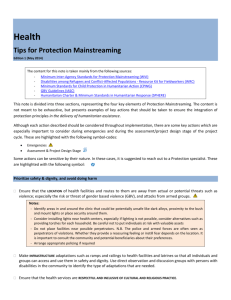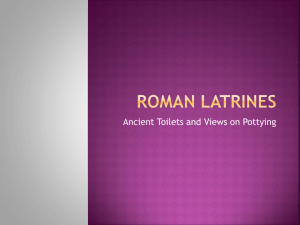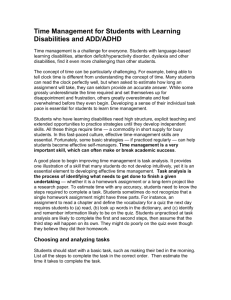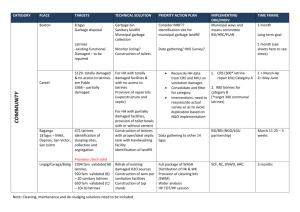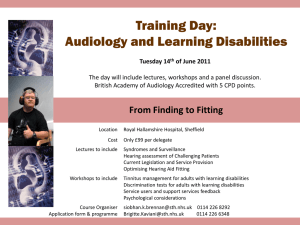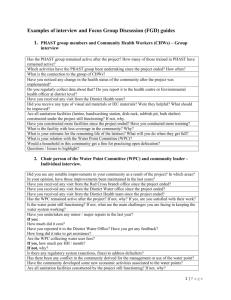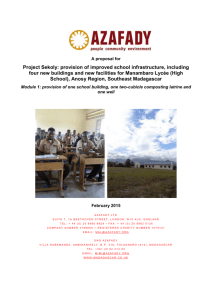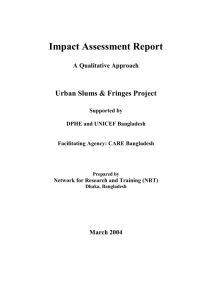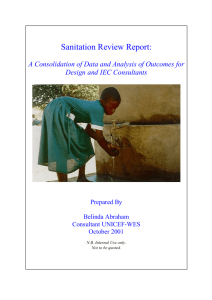WASH - Global Protection Cluster
advertisement
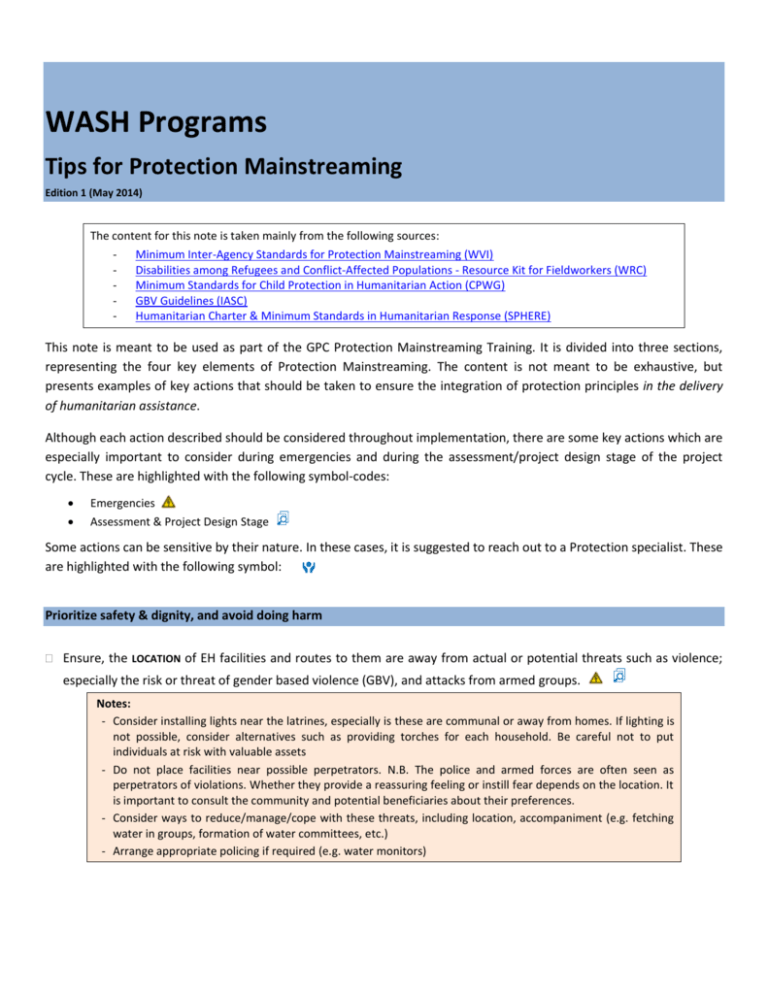
WASH Programs Tips for Protection Mainstreaming Edition 1 (May 2014) The content for this note is taken mainly from the following sources: - Minimum Inter-Agency Standards for Protection Mainstreaming (WVI) Disabilities among Refugees and Conflict-Affected Populations - Resource Kit for Fieldworkers (WRC) Minimum Standards for Child Protection in Humanitarian Action (CPWG) GBV Guidelines (IASC) Humanitarian Charter & Minimum Standards in Humanitarian Response (SPHERE) This note is meant to be used as part of the GPC Protection Mainstreaming Training. It is divided into three sections, representing the four key elements of Protection Mainstreaming. The content is not meant to be exhaustive, but presents examples of key actions that should be taken to ensure the integration of protection principles in the delivery of humanitarian assistance. Although each action described should be considered throughout implementation, there are some key actions which are especially important to consider during emergencies and during the assessment/project design stage of the project cycle. These are highlighted with the following symbol-codes: Emergencies Assessment & Project Design Stage Some actions can be sensitive by their nature. In these cases, it is suggested to reach out to a Protection specialist. These are highlighted with the following symbol: Prioritize safety & dignity, and avoid doing harm Ensure, the LOCATION of EH facilities and routes to them are away from actual or potential threats such as violence; especially the risk or threat of gender based violence (GBV), and attacks from armed groups. Notes: - Consider installing lights near the latrines, especially is these are communal or away from homes. If lighting is not possible, consider alternatives such as providing torches for each household. Be careful not to put individuals at risk with valuable assets - Do not place facilities near possible perpetrators. N.B. The police and armed forces are often seen as perpetrators of violations. Whether they provide a reassuring feeling or instill fear depends on the location. It is important to consult the community and potential beneficiaries about their preferences. - Consider ways to reduce/manage/cope with these threats, including location, accompaniment (e.g. fetching water in groups, formation of water committees, etc.) - Arrange appropriate policing if required (e.g. water monitors) Make INFRASTRUCTURE adaptations such as ramps and railings to EH facilities so that all individuals and groups can access and use facilities in safety and dignity. Use discussion groups and observation to detect/discuss this and ask the community to come up with solutions. LATRINES DESIGN must preserve the safety and dignity of its users. Notes: - If an individual does not feel safe or dignified in using the latrine, (s)he may go elsewhere, potentially exposing themselves or others to harm. - Physically separate and label the latrines “male” & “female” - Ensure latrine design accounts for children (e.g. size of pits may present a safety risk for children) - It is preferable that latrines and showers can be locked from the inside to ensure privacy. Discuss this with beneficiaries what they would prefer. Example: Children in one country were reluctant to use traditional sliding locks and had alternative ideas (e.g. wood and nails) EH FACILITIES DESIGN must preserve the safety and dignity of its users. Notes: - Raised platforms and ramps at water points to ensure safe manual lifting to all, especially children, pregnant women, and persons with disabilities. - Discuss latrine/bathing station design with various groups – including children and people with disabilities – and adapt the design, if necessary, to accommodate their specific needs. In one Education program, the staff knew that children would need latrines. They did not talk to the children, who it was later found out were afraid of the size of the hole. Children continued to defecate outside the latrines, which created a hygiene problem. - Ensure separate toilet and bathing facilities for males and females. Make sure they are clearly marked in pictorial form and work with community to ensure they are used by the indicated sex. - Consider that women and children are the most likely to be collecting water, and might be waiting in the sun for hours for a turn to fill their jerry can. Establish safe and shaded waiting areas where possible. - Schedule water collection times to limit overcrowding at the water points; collection in shifts. - Children should not carry jerrycans. However, assuming they will be forced to do so, make sure that jerrycans are not so large as to cause injury. - Ask individuals collecting water when they would prefer taps/pumps to be open. Recognize that different people have different work schedule, women and girls who are typically the water collectors have specific times when they are busy making meals. - Ensure that you have discussions on latrine/shower design with various groups and adapt the design, if necessary, to accommodate their specific needs. Topics to discuss include: privacy (make sure ‘walls’ are providing sufficient/safe cover), that persons with disabilities can access the services without or with minimal additional help. Consult the community on their preferences regarding the design. In one Burmese camp, women requested walls for privacy, but without a locking door, which was felt could create an environment for assault. In several other settings, beneficiaries especially requested locking doors. This highlights - Foresee menstrual hygiene needs for women and provide appropriate hygiene materials to individuals and groups with unique needs. Include strategies to dispose of hygiene materials. If setting up EH facilities for displaced communities, consult them as well as host communities about EH needs so as to AVOID COMMUNITY TENSIONS. Make sure that there is no tension or inequality that could lead to violence and harassment of one group or another. Notes: - Assess whether inequitable access to water and / or sanitation facilities is causing tension or conflict within the community AND with other surrounding communities. - In camp settings, consider providing services to the local community as well. - Example: In one program, an agency built latrines for IDPs living with the host community. Once the latrines were built, the host community prevented IDPs from accessing the latrines. Ensure CLEANING CHEMICALS are stored safely (e.g. for cleaning EH facilities) Notes: - Children and adolescents can mistake chemicals – especially water purifying tablets – for candy or prophylactics. Proper awareness raising combined with proper storage can prevent improper use. Meaningful Access Ensure that the LOCATION of water points and latrines are accessible to all. Notes: - Discuss with all representative samples of society (e.g. men, women, girls, boys, elderly, ethnic groups, persons with disabilities) that should have access to the service. Adapt the location to reduce the distance and to ensure that the most vulnerable/marginalized have access. - Considering that most often women and children collect water, talk to them directly about the safety of the location and the routes to the location. Ensure that services can be accessed by PERSONS WITH REDUCED MOBILITY (e.g. persons with physical disabilities, the elderly, bed-ridden individuals) Notes: - Make access paths smooth and fit ramps for wheelchair access. Consider different physical disabilities. Hand pedal wheelchairs require more space. Artificial limbs may make even relatively short distances difficult. Talk to persons with physical disabilities about what solutions would best fit their needs. - Install handlebars and removable seats in latrines for persons with disabilities. Permanent seats risk being removed or unused if it does not fit with traditional practice. - Provide bed pans for bed-ridden individuals. - If some cannot access the services, ensure that special arrangements are made to bring water to them. It should not be assumed that friends and family will do it, as this can result in children being forced to carry heavy jerrycans. In Darfur, donkey carts were hired to carry water once per week to low-mobility individuals. Ensure that beneficiaries KNOW their right to safe drinking water, and where/how to obtain it. Notes: - Rights awareness should be provided in sufficient quantity in languages understandable to all beneficiaries, especially to new arrivals in displacement settings. - Printed materials should consider literacy levels (e.g. use of pictograms or verbal communication instead of text). Lack of awareness about rights and services is regularly a gap identified in assessments. - Consider public private partnership approaches in water service provision in non-emergency setting as this will ensure that right to adequate water is commensurate to responsibility of individuals and communities in ensuring that safe water is provided and maintained MONITOR access, discrimination, and whether any water or other services are being diverted. Notes: - Ensure project indicators (e.g. # of individuals accessing services) are disaggregated by age, gender, and location or specific group (e.g. persons with disabilities, ethnic minorities). - Compare usage figures to existing demographic data. Discrepancies can tell you which groups do not have access. - Where possible train the EH committees and beneficiaries to do this. Committees can work with contractors to make sure designs are disability friendly. - Make sure services are reaching the most vulnerable. Identify what are the POWER DYNAMICS within the intervention area. Who has access to water resources? Who has access to decision making and the ability to influence decisions on water resources? Notes: - Consult with the Protection Cluster/ Protection Actors, including the GBV and Child Protection sub-clusters, about power dynamics in the area of intervention. - Consult community members on power dyamnics as perceive by them and how equity can be achieved in their perspective - Use this information to inform monitoring activities and identify any barriers to access or discrimination against particular groups. Take this into consideration when determining locations for EH facilities. Accountability, Participation & Empowerment Identify LOCAL AUTHORITIES AND CIVIL SOCIETY specialized in working with PERSONS WITH LOW MOBILITY OR DISABILITIES. Strengthen and support their role, and learn from their experience how to improve service delivery. Notes: - Coordinate with specialized agencies to identify low-mobility individuals and include them in the program assistance. Most countries already have national or local NGOs offering services to vulnerable groups. These may not operate in the same areas, but could become a valuable resource for the training of staff and the referral of cases. - Actors operating in the same locality could help mobilizing low-mobility individuals for key activities. - Notable international NGOs working on these issues include Handicap International and HelpAge - Ensure inclusion of people with special needs in management committees for EH facilities Coordinate with local authorities, as well as the education and health sectors to ENSURE THAT PUBLIC SPACES, SCHOOLS, AND HEALTH POSTS ALSO HAVE EH SERVICES. Before leaving an area, make sure that the responsible actors and systems for EH facility MAINTENANCE are in place. Notes: - This will involve coordination with local authorities and possibly suppliers, but should focus on community capacities to maintain the structures in place (e.g. EH committees). - In schools, student environment committees can be made responsible to monitor hygiene of EH facilities and report to the persons responsible for maintenance. - Identify patrons in schools to guide activities of the school health/environmental clubs/committees REPORT AND SHARE PROTECTION CONCERNS with the Protection cluster, including the GBV and Child Protection sub- clusters. Other actors may be able to provide assistance. Notes: - Cases of violations should be referred promptly and in accordance with standard operating procedures established in the area. - Sensitize communities on what constitutes violation Set up accessible, well understood MECHANISMS FOR SUGGESTIONS AND COMPLAINTS. Notes: - Do not assume an “open door” policy is enough. Make sure that there are other possibilities for submitting complaints that do not require the beneficiary exposing themselves to project staff. - RESPOND to complaints, regardless of whether corrective measures can/need to be put in place. - Staff the mechanism with both men and women and ensure it is accessible for children. - Organize awareness raising sessions so that people know how it works. - Consider a joint complaints mechanism with other sectors (e.g. Protection) to minimize confusion. Make sure to CONSULT all layers of society when identifying and responding to EH needs Notes: - Different criteria may affect the power dynamics. For example, in some places it will be important to consult different socio-economic groups (e.g. ethnic or economic minorities). In all situations, one should include women, men, boys, girls, the elderly, and persons with disabilities to understand their needs and preferences for location, design, and methodology of EH assistance. - It is not enough to just consider the EH needs of all layers of society. They have to be involved in identifying the solutions. In addition to making the response more relevant and potentially durable, this will build the confidence and self-esteem of the beneficiaries concerned. Example: In one Education program, the staff knew that children would need latrines. They did not talk to the children, who it was later found out were afraid of the size of the hole. Children continued to defecate outside the latrines, which created a hygiene problem. Find out what are the COPING STRATEGIES. Where do people get water when there is shortage? Where do people go to the toilet? Are they placing their safety and dignity at risk? Risks must be recognized as soon as possible and interventions undertaken to help people avoid resorting to negative coping strategies. Notes: - If there is a water shortage, do women travel long distances to get water and are they at risk? Consider accompaniment or water deliveries. - During migration in search pasture and water, are women and children left behind? If so, what are their coping mechanisms then? - Consider learning from local practice. Certain local plants combined with water boiling can create a filtering effect (e.g. Morninga Seeds). Displaced communities especially may not know these techniques that could help mitigate water born diseases in cases of water shortage. Ensure that EH COMMITTEES are REPRESENTATIVE of all layers of society (e.g. gender, age, ethnicity, socio-economic group, etc.) and that all members are trained on “protection mainstreaming principles”. Notes: - They can play a key role in identifying issues related to exclusion, discrimination. - If at all possible, provide the water committee with guidance on ‘peaceful’ resolution of conflicts (e.g. in managing queues, etc.) - Sometimes it is necessary to be proactive to ensure meaningful participation from groups that don’t traditionally speak out. - Insure that the voice of minority groups is represented in all committees managing EH facilities.
